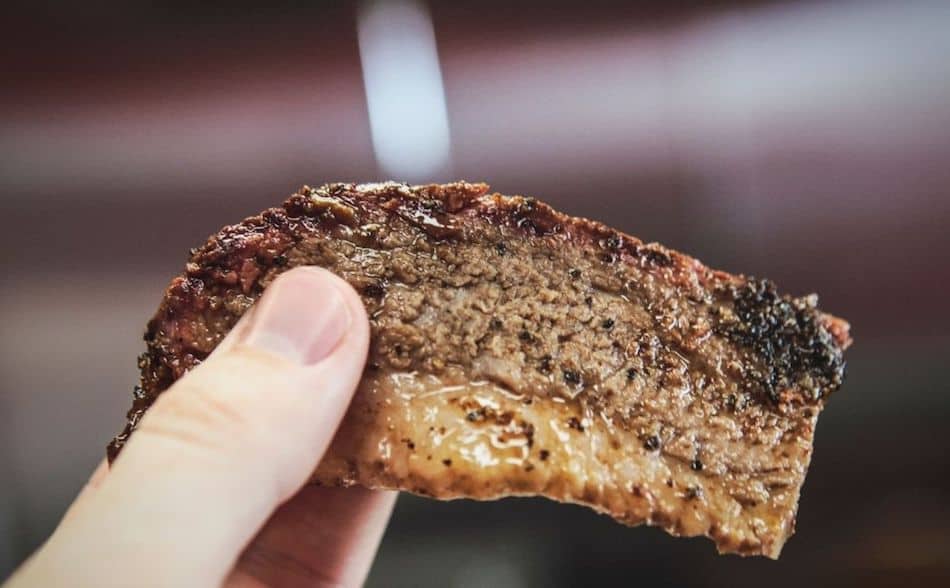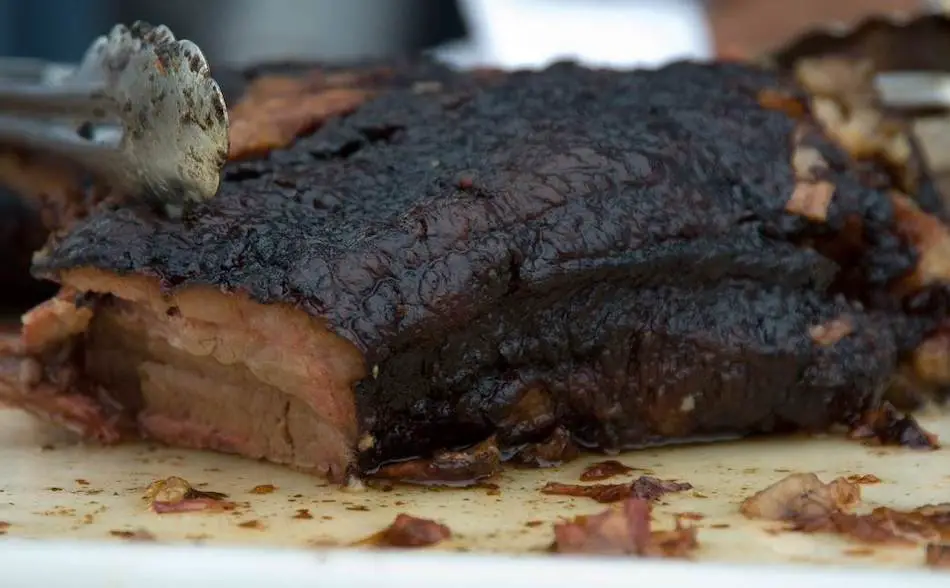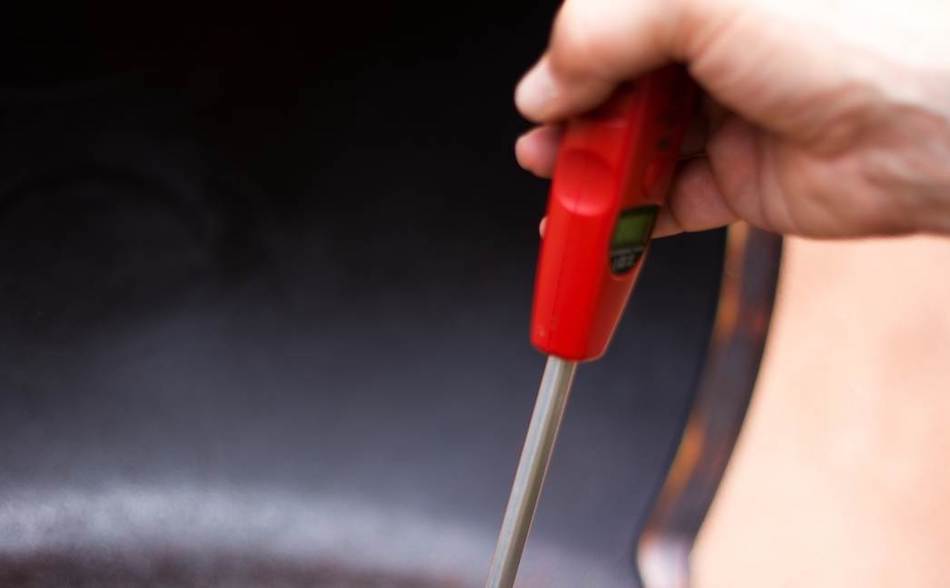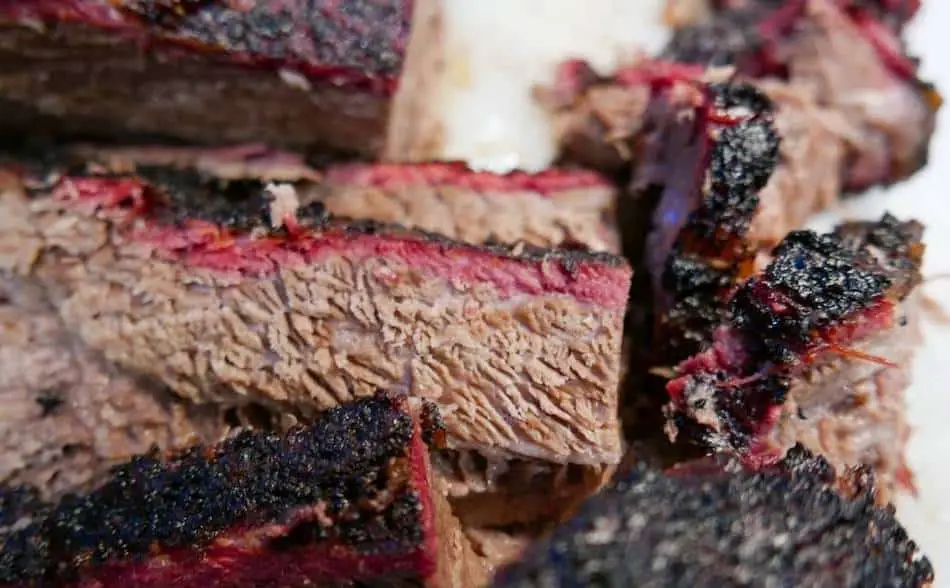Removing a brisket from the smoker too early can result in a chewy texture, while leaving it in for too long can cause it to dry out. To ensure that your brisket is cooked to perfection, it is important to know the ideal temperature at which to remove it from the smoker. In this article, we will explore the best temperature to remove brisket from the smoker according to some of the world’s top barbecue pitmasters, as well as how to test for tenderness and other considerations to keep in mind while cooking.
The ideal temperature to remove your brisket from the smoker is anywhere between 195°F and 203°F. However, most barbecue experts don’t go by temperature alone. Performing a tenderness test is the best way to tell if brisket has reached ideal tenderness. Poke the brisket with a toothpick or thermometer probe. If it feels like poking a stick of butter, then you have reached ideal tenderness. If there’s some resistance, then it needs a little longer.
Key Points
- The ideal temperature to remove brisket from the smoker is between 195°F and 203°F, but the best way to test for ideal tenderness is by using a toothpick or thermometer probe.
- If the brisket feels like poking a stick of butter, it has reached ideal tenderness.
- The magic number for the perfect brisket seems to be 203°F, but every brisket is different and may be ready at a different temperature.
- If the brisket is done at around 190°F, it may be a little underdone and chewy if not tested for tenderness.
- If the brisket is done at around 210°F, it may fall apart and may not be suitable for slicing.
- To test for tenderness, use a toothpick or thermometer probe and insert it into the brisket. The probe should feel like it is going into a stick of butter with no resistance.
- The jiggle test, where you give a slice of brisket a little jiggle, is a sign that it is cooked perfectly.
- A smoked brisket should look very dark and almost black, like a burnt meteorite.
- It is important to use a wireless thermometer to monitor the temperature of the brisket as it cooks.
203°F: The Magic Number For Smoked Brisket
The internal meat temperature of 203°F is often considered the magic number for achieving the perfectly smoked brisket. This is because at this temperature, the brisket should have reached the ideal level of tenderness and flavor. However, it is important to note that every brisket is different and may be ready at a different temperature. Therefore, it is important to not rely solely on your thermometer and to also test for tenderness using a toothpick or thermometer probe. To do this, insert the probe into the brisket and see if it feels like it is going into a stick of butter with no resistance. If there is some resistance, the brisket may need more time to cook. By learning to test for tenderness, you can ensure that your brisket is cooked to perfection every time.
| Temperature Range | Tenderness |
|---|---|
| 190°F | Underdone and chewy (if not tested for tenderness) |
| 195°F – 203°F | Ideal |
| 210°F | Falls apart, may not be suitable for slicing |
Brisket at 190°F
There may be instances where your brisket is done cooking at a temperature of around 190°F. In this case, it is important to test for tenderness to ensure that the brisket is ready to be removed from the smoker. If the brisket passes the tenderness test, it is okay to remove it from the smoker at a temperature of around 195°F. However, be cautious when removing the brisket in the 190°F range. At this temperature, the brisket may be somewhat underdone and chewy. The meat itself will be safe to eat, but the connective tissue may not have had enough time to break down, resulting in chewy brisket. To avoid this, continue cooking the brisket until it reaches an internal temperature of at least 195°F and passes the tenderness test.

Brisket at 210°F
If you take the brisket up to a high temperature, such as 210°F, it may become too tender and fall apart. While this might be okay if you’re planning to shred the meat for pulled beef, it may not be ideal if you want to slice the brisket into thin, firm slices.
To achieve a nice, firm slice of brisket, it’s important to stop cooking the meat before it reaches the point of falling apart. A good rule of thumb is to remove the brisket from the heat when it reaches an internal temperature of around 190-195°F. This will ensure that the meat is tender and juicy, but still holds its shape when sliced.
It’s also important to allow the brisket to rest for at least 30 minutes after cooking, as this will help the juices redistribute and make the meat easier to slice. Slicing the brisket against the grain (i.e., perpendicular to the direction of the muscle fibers) will also help make it more tender.
The Jiggle Test
The “jiggle test” is a technique used by BBQ pitmasters to assess the doneness of a brisket. It involves gently shaking or jiggling a slice of the meat to see how it responds. A properly cooked brisket should have a slight jiggle or bounce when shaken, indicating that it is tender and moist.
The jiggle test is often used as a final check before serving the brisket, as it can give the cook a good idea of the overall quality of the meat. A brisket that passes the jiggle test is likely to be juicy and flavorful, and will likely be well-received by diners.
It’s important to note that the jiggle test is just one tool that can be used to assess the doneness of a brisket. It’s generally a good idea to use a meat thermometer to check the internal temperature of the meat as well, as this will give you a more accurate picture of the meat’s doneness. The internal temperature of a properly cooked brisket should be around 190-195°F.
| Method | Description |
|---|---|
| Toothpick or thermometer probe | Insert into brisket. If it feels like poking a stick of butter, it has reached ideal tenderness. |
| Jiggle test | Give a slice of brisket a little jiggle. If it has a nice jiggle and is moist, it is cooked perfectly. |
Probe Tender – What Does That Even Mean?
Measuring the internal meat temperature is an excellent guide, but it doesn’t mean the brisket will be perfect. Internal temperature measurements will get you close to where your brisket needs to be, but once you were in that 190° F range, you need to test for probe tenderness. A brisket may be probe tender at 195° F, or it may pass the tenderness test at 207°F. Every piece of meat is different, so 203°F may not be the perfect done temperature for your brisket. Therefore, training yourself to test for tenderness is very important.
To test for tenderness, take a toothpick, or your instant-read thermometer, and slowly stick it into the brisket. Brisket should have no give. That should be no resistance when you insert the toothpick or thermometer. They say it should feel like sitting a toothpick into the stick of butter. You will get used to this. After a few briskets or pork butts, you will come to know what it should feel like.
What Color Should a Brisket Be?
A smoked brisket should look very dark, almost black, like a burnt meteorite. During the first 5 to 7 hours of cooking, the brisket will sit in the smoker, absorbing smoke from the wood chips or logs. This is what gives the meat its distinctive smoky flavor and dark, almost black appearance.
However, it’s important to be careful not to expose the brisket to too much smoke, as this can lead to a bitter taste. One way to prevent this is to wrap the brisket in foil or butcher paper after the first 5 to 7 hours of cooking. This will help seal in the moisture and prevent the meat from absorbing any more smoke.
After the brisket has been wrapped, the focus shifts to bringing the internal temperature of the meat up to around 203°F. This is the temperature at which the collagen in the brisket will begin to break down, resulting in a tender, juicy piece of meat. Once the brisket has reached this temperature, it can be removed from the smoker and allowed to rest for at least 30 minutes before slicing and serving.

Wireless Thermometers – Your Most Important Tool
You don’t need many accessories to smoke meat, but a meat thermometer is non-negotiable. Never trust the inbuilt thermometer on your smoker, they can be inaccurate. If you want to test it out, unscrew it and perform an Ice Bath Test. Instead, get yourself a duel-probe wireless thermometer. This will help you track the internal temperature of your meat and allow you to monitor your smoker. A good thermometer will allow you to monitor both at the same time.
There are loads of thermometers on the market, and you can spend a lot of money on fancy Wi-Fi thermometers, or you I can spend as little as $50. I can only go out and you can check it out here.
Did you know there’s now a meat thermometer with no wires that can control with your phone? Check out MEATER
Instant-Read Thermometer – Getting That Final Temp Reading
Using an instant-read thermometer can be extremely helpful when cooking a brisket, as it allows you to monitor the internal temperature of the meat and ensure that it is cooked to the desired level of doneness. Instant-read thermometers are particularly useful during the final stages of the cook, as they allow you to get precise temperature readings in different areas of the brisket. This is important because the thicker parts of the meat may take longer to cook and may have a different temperature than the thinner sections.
When buying an instant-read thermometer, it’s important to choose one that is accurate and reliable. Cheap, low-quality thermometers may be inaccurate, which can lead to overcooked or undercooked meat. Look for a thermometer with a digital display and a probe that is thin and sharp, as these features will allow you to get a more accurate reading.
It’s also a good idea to invest in a thermometer with a wide temperature range, as this will allow you to use it for a variety of different cooking tasks. Some instant-read thermometers are designed specifically for use with meat, and may have features such as a built-in timer or temperature alarms to help you cook your brisket to perfection.
I’ve written a full guide that you can check out here: Best Instant Read Thermometers.

How Long Does it Take to Smoke Brisket?
The time it will take to smoke your brisket will depend on the temperature you are cooking, and the size of the brisket. Also, it will depend whether you wrap the brisket. Some pit masters choose not to wrap their brisket, so it will take longer if you smoke it naked. The average brisket will take 10 to 15 hours if cooked at 225°F. You can cook at a higher temperature and get it done sooner. Hot and fast briskets have become a trend, with people knocking out of brisket in about 5 or 6 hours at 300°F. Before you attempt this, check out my article that I wrote a while back. If you are going to attempt a hot and fast brisket, you need to know what you’re doing.
| Brisket Size | Cooking Time | Target Internal Temperature |
|---|---|---|
| 4-6 lbs | 10-12 hours | 190-195°F |
| 6-8 lbs | 12-14 hours | 190-195°F |
| 8-10 lbs | 14-16 hours | 190-195°F |
| 10-12 lbs | 16-18 hours | 190-195°F |
It’s important to note that these cooking times and temperatures are approximate and may vary based on a variety of factors, including the type of smoker or grill being used, the ambient temperature, and the desired level of tenderness.
How Long Should I Rest Brisket?
It’s important to allow a brisket to rest after it has been cooked in order to allow the juices to redistribute throughout the meat. If you slice the brisket too soon after cooking, the juices will likely run out, resulting in dry, overcooked meat.
To avoid this, it’s a good idea to let the brisket rest for at least 30 minutes before slicing. This can be done by simply leaving the brisket in its wrapping and allowing it to sit at room temperature.
If you have the time, you can also let the brisket rest for longer by placing it in a cooler. This is a popular technique among BBQ pitmasters, as it allows the meat to continue to cook and tenderize while it rests. To do this, simply wrap the brisket in foil or butcher paper and place it in a cooler with a few towels or blankets to keep it warm. Let the brisket sit in the cooler for at least an hour, or even up to several hours, before slicing and serving.
When you’re ready to slice the brisket, simply vent the foil or butcher paper by opening it up a little, and let the meat sit on the counter for at least 30 minutes to allow it to come to room temperature. This will make it easier to slice and help ensure that the juices stay in the meat.
“How Long Should I Rest Brisket?“
Holding Brisket in a Cooler
Holding a brisket is a technique used to keep the meat at a constant, high temperature for an extended period of time. This can be useful if you need to keep the brisket warm while you finish preparing other dishes, or if you’re waiting for guests to arrive before serving.
To hold a brisket, simply wrap it in foil or butcher paper after it has finished cooking, and place it in a dry cooler or insulated box. The insulated environment will help to keep the brisket at a high temperature, typically around 150-170°F, for up to 4 hours.
When you’re ready to serve the brisket, simply remove it from the cooler, unwrap it, and slice it as desired. The meat should still be hot and moist, as if it had just been removed from the smoker.
It’s important to note that holding a brisket is not a substitute for proper resting, which is an essential step in the cooking process. A rested brisket will be more tender and juicy than one that has been held for an extended period of time. It’s generally a good idea to allow the brisket to rest for at least 30 minutes before holding it in a cooler, and to slice and serve it as soon as possible after it has been removed from the cooler.

World Brisket Champion Harry Soo is now sharing his secrets with his Competition Meat Rubs.
How to Slice Brisket
When slicing a brisket, it’s important to slice against the grain of the meat in order to achieve the most tender slices possible. The grain of the meat refers to the direction in which the muscle fibers are aligned. Slicing against the grain means cutting the meat perpendicular to the direction of the fibers. This helps to break up the fibers, making the meat more tender and easier to chew.
To slice a brisket, start by separating the point from the flat. The point and the flat are the two main sections of a brisket, and the grain of the meat runs in different directions in each section. The point is typically fattier and more marbled, and is often used for pulled beef or chopped beef sandwiches. The flat is leaner and more uniform in texture, and is the preferred section for slicing.
To slice the flat, start by trimming away any excess fat or gristle. Then, using a sharp knife, slice the meat against the grain into thin slices, about 1/4 to 1/2 inch thick. Slicing the brisket thin will help to ensure that it stays moist and tender, even if it has been held for an extended period of time.
It’s also a good idea to slice the brisket just before serving, as this will help to retain its moisture and flavor. If you need to slice the brisket in advance, wrap the sliced meat in foil or butcher paper and store it in the refrigerator until ready to serve.
Brisket Leftovers
It’s generally a good idea to only slice as much of a brisket as you will need at a given time, rather than slicing the entire piece of meat all at once. This will help to ensure that the remaining meat stays moist and flavorful, and will make it easier to store and reheat leftovers.
If you have leftover brisket, it’s generally best to save it as a whole piece rather than as sliced meat. This will help to retain the moisture and flavor of the meat, and will make it easier to store and reheat.
One of the best ways to preserve leftover brisket is to use a vacuum packaging machine. A vacuum sealer works by removing the air from a storage bag or container, and sealing the bag or container shut. This helps to prevent the meat from drying out, and can extend its shelf life by several days.
To store leftover brisket using a vacuum sealer, simply wrap the meat in foil or butcher paper, and place it in a vacuum-sealed bag. Follow the manufacturer’s instructions for your vacuum sealer to remove the air from the bag and seal it shut. The sealed bag of brisket can then be stored in the refrigerator or freezer until you’re ready to reheat and serve it.
You can restore brisket by reheating using the sous vide method, which you can read about in this article.

Standard Barbecue Rub

I found this great rub recipe through How To BBQ Right. I use this recipe and alter it slightly depending on what I'm cooking. Made by the guys at Townsend Spice & Supply: https://townsendspice.com/
Ingredients
- - ½ Cup Paprika
- - ½ Cup Salt
- - ½ Cup Sugar
- - ½ Cup Granulated Garlic
- - ¼ Cup Granulated Onion
- - ¼ Cup Chili
- - ¼ Cup Cumin
- - 2 Tablespoons Black Pepper
- - 2 Tablespoons Dry Mustard
- - 1 Tablespoon Cayenne Pepper
Instructions
- Combine all the spices together in a large mixing bowl
- Store rub in rub shakers
This brisket injection marinade is the secret used in competitions and made by a World Barbecue champion.
My Favorite Brisket Tools
Thanks for checking out this article. I hope you learned a few things. Here are some of my favorite tools I use when smoking brisket that may be useful to you. These are affiliate links, so if you decide to purchase any of these products, I’ll earn a commission. But in all honesty, these are the tools I recommend to my family and friends who are just starting out.
Meat Injector: Injecting meat is a great way to take your barbecue to the next level and help you make competition-style brisket. An injector is the only way you will be able to get flavor and moisture into the middle of the meat. The Beast Injector is a stainless steel injector that is sturdy and affordable. Check the latest price on Amazon here.
Brisket Marinade: The best injection solution on the market is the Butcher BBQ Brisket Injection. This marinade is used in competitions and is made by World Barbecue Champion pitmaster, Dave Bouska. You can find the marinade on Amazon here.
Butcher Paper: Wrapping brisket in butcher paper has become a huge trend in barbeque thanks to Aaron Franklin. Wrapping your brisket in paper will give you a nice brisket bark. However, you can’t just use any old paper, it has to be unwaxed, food grade paper. You can find it on Amazon here.
Brisket Rub: These days I make my own rub when possible, but I always have a few pre-made rubs for when I’m running low. Barbecue guru Malcom Reed produces Killer Hogs, one of the best brisket rubs I’ve found over the years. Another great rub is Slap Yo Daddy, made by brisket master and multiple World Barbecue Champion, Harry Soo.
Meat Thermometer: There are dozens of fancy thermometers on the market, but I still use my trusty TP20. For around $50, I have a high-quality meat thermometer with two probes, and can track the temperature of my smoker with one probe, and my meat with the other probe. The ThermoPro TP20 is an Amazon Best Seller because it’s the easiest thermometer to operate, is durable, highly accurate, and comes with pre-programmed meat settings.
Instant Read Thermometer: Arguably, the second most important tool you need is a fast and accurate instant-read thermometer. These tools play an important role in the latter stages of the cook when the meat needs regular checking in multiple areas. I use the ThermoPro TP19 because it can do everything a ThermaPen can do, but for a fraction of the cost. You can check out the TP19 on Amazon here.
Advanced Thermometer and Automatic Temperature Controller: Once you’re ready to take things seriously, the FireBoard 2 Drive is a six-channel Bluetooth/Wi-Fi thermometer that can monitor up to 6 pieces of meat, control and graph your cook sessions on your smartphone, and attaches to an an automatic blower that will convert your charcoal smoker to a set-and-forget. This is one of the most advanced meat thermometers on the market. You can check it out on the FireBoard website here.
